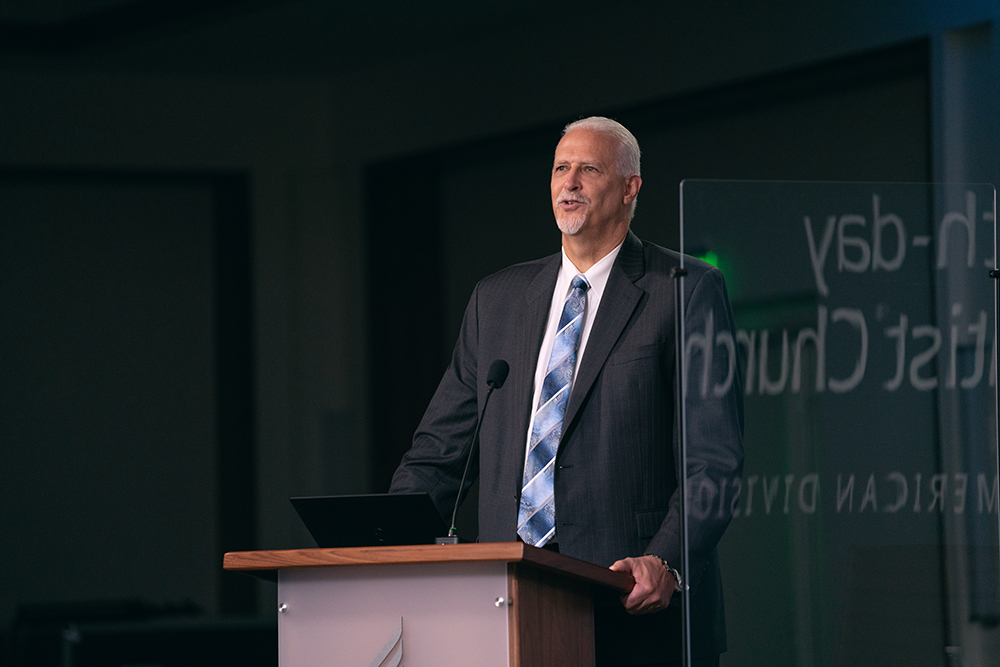
Randy Robinson, NAD treasurer, begins his report on Nov. 1, 2021, at the North American Division Year-End Meeting. Photo by Pieter Damsteegt
In the morning on Nov. 1, 2021, Randy Robinson, NAD treasurer, commenced his annual treasurer’s report at the North American Division Year-End Meeting (NAD YEM) with introducing new General Conference treasurer Paul Douglas. Douglas, at the NAD headquarters in Columbia, Maryland, addressed the NAD officers, and executive committee delegates watching via Zoom, by expressing his appreciation for working with the division.
“We are all a part of God’s work,” Douglas said, “and we have one mission that we will pursue together. It is a privilege to be here with you, together in mission, particularly at this time in earth’s history — in the closing sentences of earth’s history.”
Douglas continued, “We have different roles, but we all have the same purpose to build up the kingdom of God. I appeal to all of those who are my colleagues, especially in treasury, … we are not just about managing money, but are also about organizing money for the purpose for which God has called us. We are still under the threat of COVID, but God’s mission and purpose for us still remains the same. We must affirm that mission, … and align our resources to ensure that we are effective and efficient in caring out God’s work.”
Douglas gave his affirmation to the NAD treasurer for “a report of God’s faithfulness, and the faithfulness of His members. It’s also a report that focuses us on mission.”
Unbelievable Evidence
Before diving into his report, Robinson shared his amazement with how God has worked through His church members as he portrayed the financial backdrop undergirding his report.
Referencing in particular the months of the COVIID-19 pandemic, he said, “Even though we went through a time of uncertainty, and are still in a time of uncertainty, I look at 2020 in the context of a miracle; [it was] ‘miraculous 2020.’ Remarkably, we ended the year with a tithe gain.”
Robinson reported that the division ended the year with nearly a two percent increase in tithe, saying, “that is just an unbelievable evidence that God was with His church through the giving of His people.”
He said that as 2021 began, COVID-19 was persistent, with most churches’ physical spaces closed, schools operating in virtual learning mode, and employees working from home. “There was a lot of uncertainty still surrounding the pandemic and how that would continue to affect us in 2021. But as we continued through that process — and financially we were ascertaining what we could do to maintain financial order — we budgeted conservatively in 2021. We reduced travel budgets commensurate with the lockdowns that we were experiencing. Our budgets were constricted and reduced to a large degree,” Robinson shared.
Early 2021 showed some gains, and a better understanding of the pandemic, he said. By spring 2021, vaccines were being deployed. Churches began tentatively opening. Schools were getting more optimistic about what the new school year held for them with a mix of virtual learning, in-person learning, and hybrid situations.
“Even to this moment, while it seems the pandemic is lessening as it’s reducing its grip on our culture, our businesses, our society, we still have some uncertainty about how that will end,” Robinson remarked. “But I’m heartened, again, at God’s grace. Even with all of this continuing uncertainty, God has blessed His people. He’s blessed His church through the giving of His people, and I’m amazed at what God is doing.”
Robinson paused to address the delegates and the officers before continuing. “Our tithe gain through September in the North American Division remains at over 12 percent year-over-year,” he said. “It’s a praise-our-God moment. What a gracious and caring God we serve! I pray that He’ll give us the grace to be faithful stewards of the abundant resources He’s provided for us even in times that are so uncertain. I praise God for [His] amazing goodness and the amazing response of His people in the North American Division through their giving.”
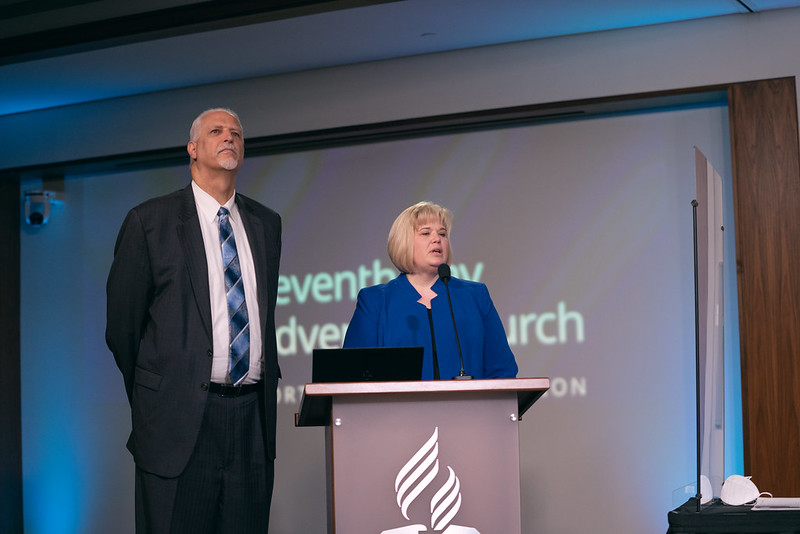
Randy Robinson and Judy Glass, NAD undertreasurer, share the 2022 proposed budget to the 2021 year-end meeting delegates. Photo by Pieter Damsteegt
Financial Highlights
Robinson shared highlights from the 2020 audited financial statement, including operating and plant fund trends, recommended working capital, and tithe. He also shared the 2022 proposed budget with Judy Glass, NAD undertreasurer.
During the 2022 budget presentation, Glass explained that during 2021, project and travel budgets had been cut. The 2022 proposed budget reinstates both of those items. “It restores the travel budget to 85 percent of pre-COVID levels and it restores our project budgets to our departments to 100 percent of the pre-COVID budget levels,” she said. “We’ve talked some about evangelism this morning and we’re happy to let you know that during the year of [multiply] in 2022 we’ve added an additional $1.1 million of funding that is for direct evangelism.”
As he addressed the 2020 audited financial statement, Robinson reported that after the operating fund total net assets dipped in 2017 when the NAD purchased its headquarters building, operating and combined operating and plant total net assets have trended upward through 2020. Liabilities have followed that same trend due, in large part, to the tremendous increase in member use of the AdventistGiving platform. “Use of the platform creates a temporary liability on our statement that is eliminated once funds are passed back to the local churches,” he said.
In addition, working capital climbed from 85 percent of the recommendation in 2018 to 92 percent in 2019, ending with 109 percent in 2020. According to Robinson, a recommended working capital of 100 percent is optimal, as defined in NAD working policy.
He shared that the NAD had 272 days of cash available at the end of 2020. It was 209 at the end of 2018, and 235 at the end of 2019. “Recommended working capital is a North American Division policy that suggests a certain level of liquid assets that should be available to do business. I use an additional financial metric of ‘days of cash available’ to help define our financial health. That number should be between 180 and 210 days of cash as I calculate it. We are at 272 per our 2020 audit,” he reiterated.
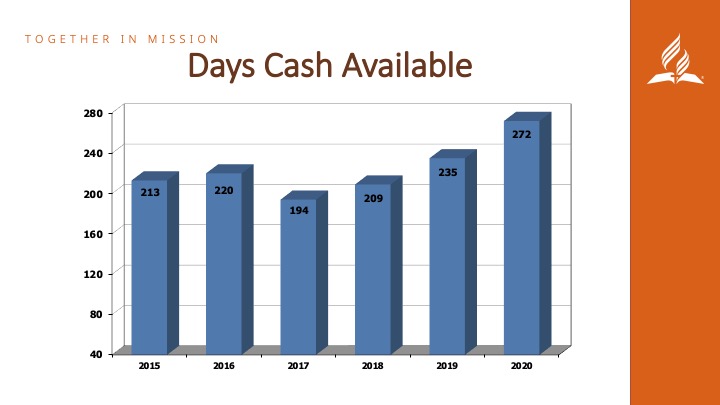
Gross tithe in 2019, Robinson reported, was $1.075 billion. Tithe annually from 2016 to 2019 reached $1 billion, but then COVID-19 hit in early 2020. Because of the pandemic and subsequent economic downturn, there was speculation that tithe might be down double-digit percentages. But that wasn’t the case and 2020 ended with tithe at $1.093 billion. And, said Robinson, for 2021, “we have a more than 12-percent year-over-year gain in tithe through September; and nine out of nine unions have a gain. … Additionally, through September, 58 out of 59 conferences have gains year-over-year and most of those conferences have double-digit gains. I’m just in awe of the amazing reality that God has [provided] — in a demonstration of God’s benevolence to us through the giving of His people.”
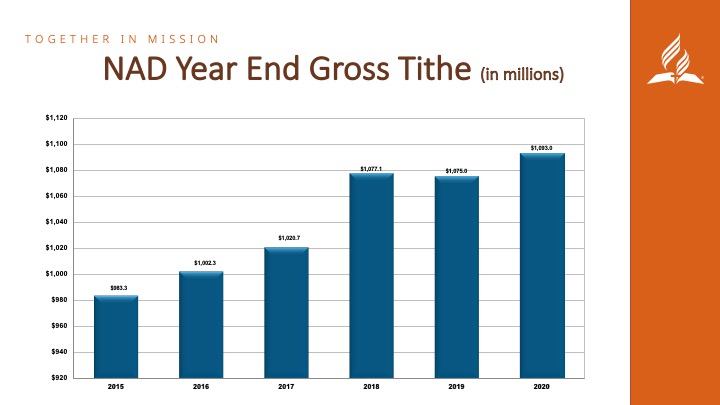
Mission to the Cities
“There’s no other explanation [for this year] except God’s Goodness through His people,” Robinson continued. “We have an increase in our income year-over-year. We have managed expenses well. We’re under budget, and we have an operating gain of $15 million through September.”
Robinson mused about what questions he’d ask if he were an executive committee member listening to this report. The biggest question would be: What are you planning to do if the financial trend holds of a $15 million bottom line; what are you planning to do with that surplus?
“I would answer that question really in two ways,” he said. “Number one, it is imperative that the North American Division be on sound financial footing. We strive to do that. We strive to achieve and reach and exceed the minimum standards provided to us through our policies. And at this point by God’s grace, we are doing that, and I would be a strong advocate of continuing that approach as we deal with our finances.”
The second area Robinson would address specifically is mission. “God is setting us up for some work that He wants us to do. He wants us to address mission and ministry and reaching those that we are called to reach,” Robinson remarked. “And I am convinced that we need to manage those resources in a way that allows us to deploy those dollars to the mission that we’re called.”
Robinson then turned the time briefly over to G. Alexander Bryant, NAD president, to address one of the missional objectives of the division that has emerged at the start of this quinquennium. “We have talked about — and we’ve been praying along with you about — the challenges of reaching North America with the distinctive Christ-centered message that God has given us,” Bryant said to delegates. “And one of the things I’ve shared with you are the 20 cities where 50 percent of the population of this division resides. And as the metropolitan areas continue to grow, I believe one of the things God is calling us to do is to help [our] churches in those cities [with] the resources that meet the challenges of the growing population across the board. How can we utilize our resources to help reach those individuals? We want to see the resources the Lord provides to us to help in reaching those big challenges that we have in the metropolitan areas.”
Bryant shared how there has been talk of creating more centers of influence, including food distribution centers, counseling centers, vegetarian restaurants, and/or places for young people; and how to support unions, conferences, and churches in these endeavors.
“This is a conversation that we will continue to have when we move forward, but it is our thoughts and our plan that in some way that will help in the frontline missions in our large cities,” he concluded.
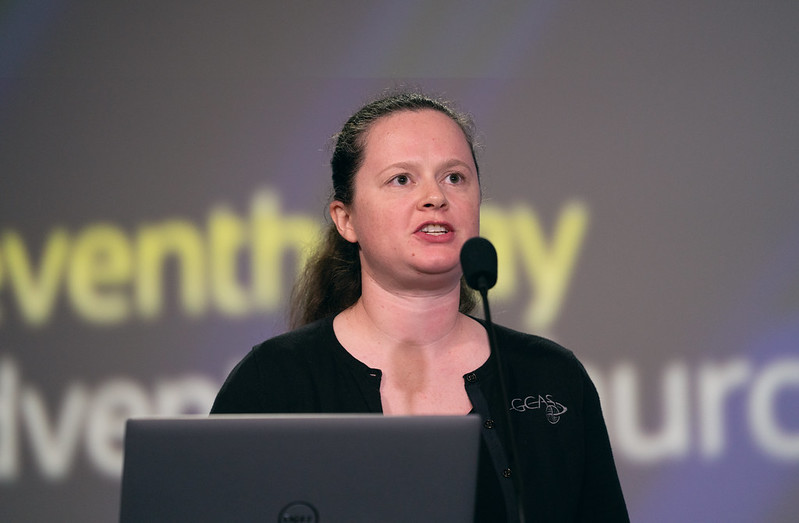
JoJean Birth, associate director of General Conference Auditing Service who is assigned North America, shares information from the NAD auditing report during YEM on Nov. 1, 2021. Photo by Pieter Damsteegt
Survey Report
Robinson also shared again a summary of the report he presented at the 2020 NAD YEM on a request from the executive committee to collect information from conferences and unions on the application of cost-of-living increases. There were 57 respondents, 48 out of 59 conferences and missions, and all nine unions, responded to eight questions. Robinson shared four questions and poll results. Questions included, “Are you behind on the cost-of-living increases voted annually?” “Have you initiated staff reductions to accommodate those costs of living increases?” “Do you feel the annual June U.S. CPI is a fair benchmark?” and “Should the NAD continue some level of cost-of-living increases into the future?” Robinson shared the results to the questions: 19 responded “yes,” while 38 responded ‘no” to the first question; 10 responded “yes,” 47 responded “no” to the second question; 42 responded “yes,” 15 responded “no” to the third question; and 54 responded “yes,” 3 responded “no” to the fourth question.
Additional Reports
Robinson imparted the investment report from Tim Aka, General Conference associate treasurer. Robinson explained that the GC policy and NAD investment policy relative to investing funds are closely followed; and that while many factors influence the financial markets in the United States and around the world, “we’ve had a net gain of a little more than five percent year-to-date through September for our North American Division operating reserves.”
Dave Weigley, Columbia Union Conference president and NAD audit review committee chair, informed the executive committee that the General Conference Auditing Service audit report for 2020 was reviewed and accepted by the audit committee in October, as was the 2019 report. The NAD executive committee voted to accept the audited financial statements for 2019 and 2020 as presented.
JoJean Birth, new General Conference Auditing Service associate director (North America area), reported on overall audit performance in the NAD. She explained that of 318 clients (in 2020), just under 40 percent of which are education related institutions, 72 percent of the audits were completed. Of the completed audits, 87 percent received “standard” or “clean” (unqualified) opinions.
Birth stated that the opinion section of the audit report will read a little differently moving forward, where the actual opinion will be moved to the beginning of the section instead of the end. She also mentioned that accounting for leases will change next year due to new FASB (Financial Accounting Standards Board) rules.
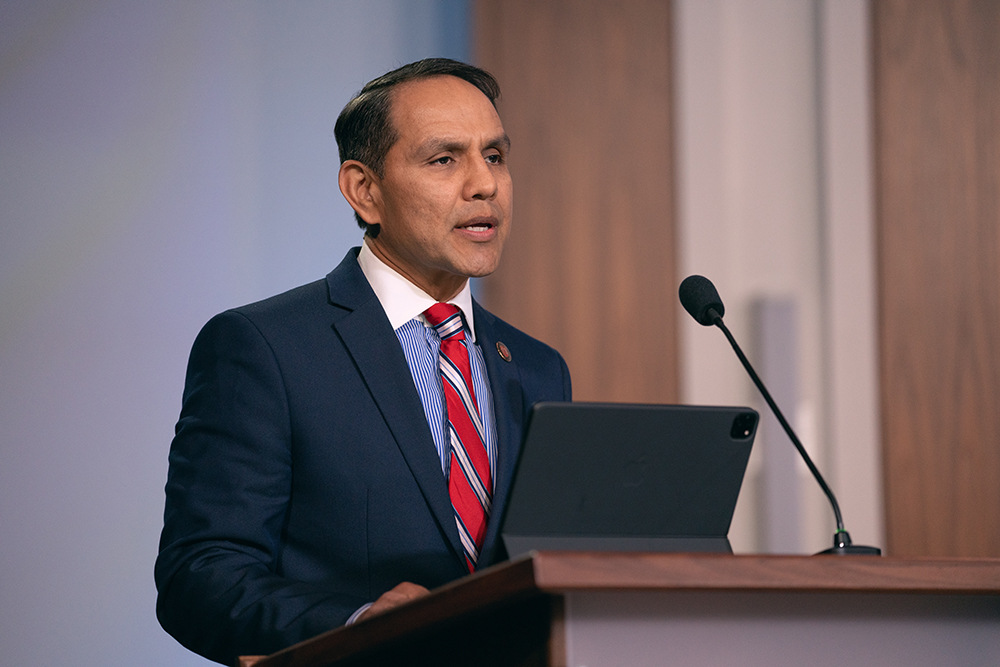
Edwin Romero, NAD Retirement president and plan administrator, presents information about the division’s eight retirement plans. Photo by Pieter Damsteegt
Edwin Romero, Adventist Retirement administrator/CEO and NAD associate treasurer, provided a presentation during the treasury report focused on sharing that the eight plans that the NAD Retirement department administers all received “clean opinions” from the external auditor with no disruption due to COVID-19.
He also described the funding streams for each of the different plans. Romero reminded the executive committee that in 2020 he had reported that the NAD Defined Benefit Plan, using certain assumptions, had the possibility of being fully funded in about 15 years. “In 2020, the expectation was to go from 15.7 years and close 2020 with 14.7 years,” he recalled. “We not only hit our target, but we outperformed the projection of the 14.7 years by .8 years or 9.6 months with 13.9 years remaining to fund this plan. So right on target – in fact, ahead – of the projection.”
Romero continued, “In 2021, the projection was 13.7 years, which we were already ahead of at the end of 2020, but we believe that we’ll be closing 2021 with 12.6 years remaining to fully fund this plan. This means that is about 1.1 years, or 13.2 months, ahead of projection. Of course, this is under the assumption that all economic conditions will remain stable between now and the end of the year.”
Romero concluded his report by sharing that Adventist Retirement has trained more than 1,000 participants with its pre-retirement seminars and financial wellness seminars via Zoom. “Folks, this is three times more than the typical year,” he exclaimed. “I’d like to express a deep appreciation and say kudos to our retirement team for a job well done. In 2020, we transitioned from a pay-as-you-go plan or a pay-as-you-go model to a fully funded model, if you will.”
“I’d like to close this report with a statement in praising God that the church, in almost 112 years, has never missed a single pension payment,” he added.
After discussion, the executive committee voted to receive each of the reports presented.
In Gratitude
Robinson, at the conclusion of his report, thanked the treasury team for their hard work throughout the year and at YEM. “This kind of report does not just fall out of the sky. It takes a tremendous amount of work — I am the beneficiary of a major group of people who puts all of this information together that allows me to compile it into this summarized form. I want to thank my treasury team. Outstanding team of individuals, of professionals, who put all of this information together,” he said.
Robinson shared the familiar verse of Jeremiah 29:11: “‘For I know the plans I have for you,’ declares the Lord, ‘plans to prosper you and not to harm you, plans to give you hope and a future’” (NIV).
“I am just amazed how God has benefited the North American Division and His church this past year in a very difficult situation under very uncertain circumstances,” Robinson closed. “He knows the plans He has for us even though we may wonder and doubt and not be certain about what those plans might be specifically. He’s faithful; and I’m grateful to God for His benevolence, for His patience, for His blessing, and for allowing us to serve Him in this way.”
